Many North Americans consider next week Spring Break, but here in Antigua, Guatemala it is called Semana Santa and is a week-long religious celebration. Here is a primer on the lingo in case you decide to visit us one year during this very festive and incredibly crowded week…
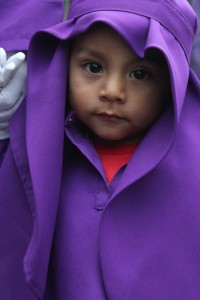 SEMANA SANTA – The Spanish phrase for Holy Week which runs from Palm Sunday through Easter Sunday.
SEMANA SANTA – The Spanish phrase for Holy Week which runs from Palm Sunday through Easter Sunday.
CUARESMA – The Spanish word for Lent, which is celebrated in Antigua with processions every weeekend for the five weeks leading up to Semana Santa. If you can’t make it to Antigua for Easter week, you can always catch one of Antigua’s Lent processions.
PASQUA – The Spanish word for Easter.
PROCESSIÓN – A religious parade which always leaves from and returns to a specific church. Processions tell the story of Jesus’ crucifixion and resurrection using elaborate floats full of iconography. More than a dozen major processions (and many more smaller processions) take place day and night in Antigua during Semana Santa. The procession tradition is said to have started in Guatemala in 1524 and, today, most Semana Santa processions include two main floats. The first carries a scene from the life of Jesus. The second carries a depiction of the Virgin Mary. Each procession is named after the specific Jesus and Mary that adorn the floats (i.e. Jesús De La Merced, Jesús El Peregrino, Jesús Del Milagro). Some processions last for 15 hours and cover many miles.
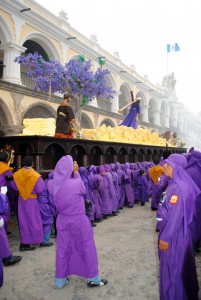 ANDA – An enormous hand-crafted wooden float which weighs up to 8,000 pounds and is carried by up to 100 people. Dozens of andas are paraded around town during Semana Santa and each carries a different tableau on top depicting a scene from the story of Jesus’ crucifixion. These scenes are changed every year, but their meaning remains the same. Some of the andas are antiques and some are new. Each church has their own own andas of varying sizes and the main characters from the andas spend the rest of the year in niches in their home churches. The andas are lit during night processions when people push generators along the procession route behind the floats.
ANDA – An enormous hand-crafted wooden float which weighs up to 8,000 pounds and is carried by up to 100 people. Dozens of andas are paraded around town during Semana Santa and each carries a different tableau on top depicting a scene from the story of Jesus’ crucifixion. These scenes are changed every year, but their meaning remains the same. Some of the andas are antiques and some are new. Each church has their own own andas of varying sizes and the main characters from the andas spend the rest of the year in niches in their home churches. The andas are lit during night processions when people push generators along the procession route behind the floats.
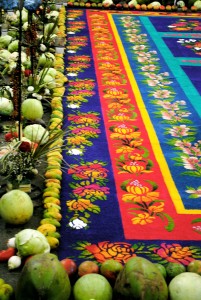 ALFOMBRA – This is the Spanish word for “carpet” and that’s exacty what these temporary, organic pieces of street art are meant to be–fancy carpets that pave the way for the andas in each procession. People spend as much as they can on alfombra ingredients which range from flowers to vibrantly dyed wood shavings and sawdust to fruits and vegetables to tiny Noah’s arcs. Styles vary too. Some are hand-made and, thus, imperfect. Others are done meticulously using stencil cut outs and exact measurements. Alfombras are typically created by an entire extended family on the cobblestone street in front of their home but local businesses create alfombras too.
ALFOMBRA – This is the Spanish word for “carpet” and that’s exacty what these temporary, organic pieces of street art are meant to be–fancy carpets that pave the way for the andas in each procession. People spend as much as they can on alfombra ingredients which range from flowers to vibrantly dyed wood shavings and sawdust to fruits and vegetables to tiny Noah’s arcs. Styles vary too. Some are hand-made and, thus, imperfect. Others are done meticulously using stencil cut outs and exact measurements. Alfombras are typically created by an entire extended family on the cobblestone street in front of their home but local businesses create alfombras too.
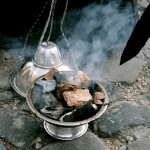 COPAL – A natural tree resin which is burned as incense by men and boys swinging incense burners in front of the main anda. Processions on Saturday seem to have the most incense. One theory is that on Saturday processions only include one anda with Mary on top (Jesus is not included because he’s been crucified and not yet risen). That anda is carried exclusively by women which leaves many men looking for a role to play in the procession so they grab incense burners.
COPAL – A natural tree resin which is burned as incense by men and boys swinging incense burners in front of the main anda. Processions on Saturday seem to have the most incense. One theory is that on Saturday processions only include one anda with Mary on top (Jesus is not included because he’s been crucified and not yet risen). That anda is carried exclusively by women which leaves many men looking for a role to play in the procession so they grab incense burners.
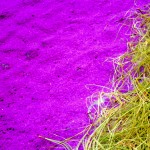 MORADO – During the first half of Semana Santa hundreds of men in Antigua put on a silky purple tunic and sash with a head dress or hood. Why purple? Because it is the liturgical color of Lent and some believe it symbolizes Jesus’s pain and suffering and emulates the color of a robe that covered Jesus. Purple has historically been considered the color of royalty. The costume switches to all black on Good Friday afternoon following Jesus’s crucifixion.
MORADO – During the first half of Semana Santa hundreds of men in Antigua put on a silky purple tunic and sash with a head dress or hood. Why purple? Because it is the liturgical color of Lent and some believe it symbolizes Jesus’s pain and suffering and emulates the color of a robe that covered Jesus. Purple has historically been considered the color of royalty. The costume switches to all black on Good Friday afternoon following Jesus’s crucifixion.
VIERNES SANTO – Semana Santa celebrations in Antigua reach their peak on Viernes Santo or Holy Friday with four major processions in town and very large crowds. The action starts at midnight with the Peregon de Romanos. Some processions begin at 4 am on Friday morning and some don’t finish until 6 am Saturday morning. Graphic and emotional re-enactments of the crucifixion of Jesus also take place inside churches on Viernes Santo and by 3:00 pm everyone has changed out of their purple clothes and into black clothes in mourning for the crucified Jesus.
DOMINGO de RESURRECCIÓN– The celebration of Jesus rising from the dead marks the end of Semana Santa but Easter Sunday is not the peak of the celebrations, Good Friday is. Processions on Easter Sunday have a unique celebratory vibe with fireworks, folks waving yellow and white flags and confetti in the air.
The angel said to the women, “Do not be afraid, for I know that you are looking for Jesus, who was crucified. He is not here; he has risen, just as he said. Come and see the place where he lay. Then go quickly and tell his disciples: ‘He has risen from the dead and is going ahead of you… Matthew 28:5-7
*Special thanks to Lonely Planet for their extensive Semana Santa definitions.
